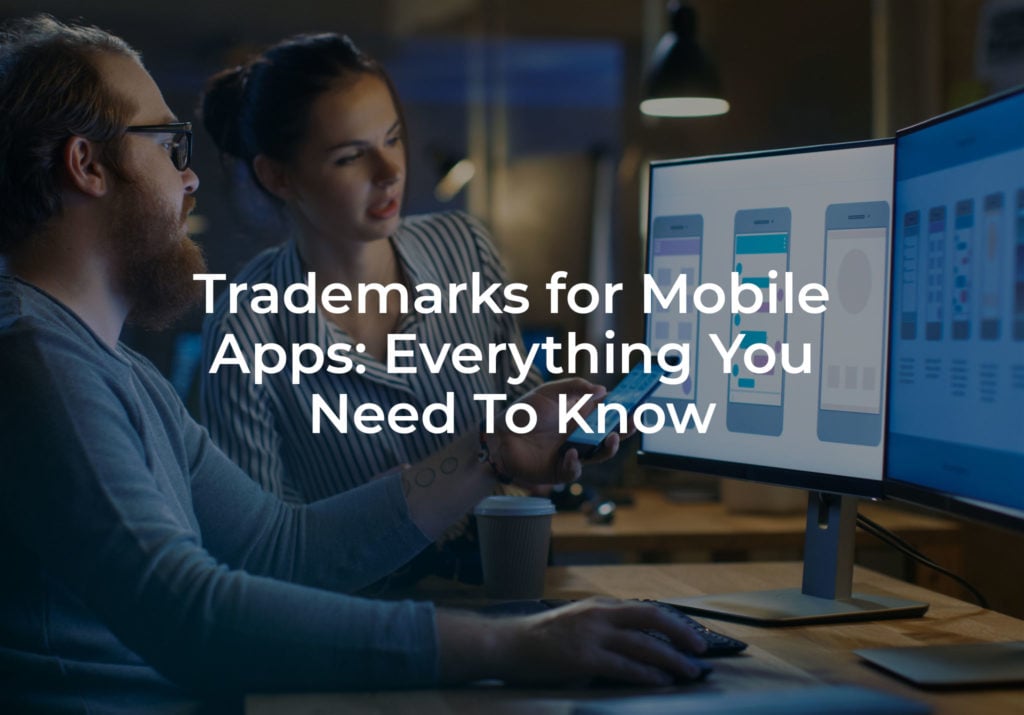Brand identity is one a company’s most valuable assets. This is especially true for SaaS and mobile app companies whose consumers do not recognize them or their goods and services based on a physical interaction at a particular venue or with specific persons. Instead, their interaction is primarily with the names, logos, icons, UI, and slogans that they see on the company’s mobile app, website, or online marketplace. Likewise, for a new software company or mobile app, consumers will not have any established brand recognition between your business and the software application. Rather, their first impression will be based off the trademarks they encounter in connection with their use of the software.
Whether it is a name, logo, icon, or slogan, your trademarks become the first impression of your company and products, allowing new consumers to develop trust in your reputation and in your goods or services. Particularly with mobile apps, there are numerous companies seeking to gain a competitive advantage in their specific market sector in an often super saturated market space. To distinguish your software from the rest of the “pack,” creating and registering the trademarks associated with your software, features, and functionality will help you quickly establish brand recognition amongst your consumers.
Can You Trademark a Mobile App?
Trademarks are designed to protect the consumer-facing markings and brands that identify the source of your goods and services. In the case of a software platform or mobile app, this can include the name of the mobile app or the app developer, any slogans or taglines, and the unique logos and icons. Specifically, the protection may extend to the name or other wording or lettering which are used to identify the source of the software goods or services. Remember, brand recognition is developed from consumer recognition so you will want to protect the marks that are being most frequently displayed.
Trademarks do not protect the underlying software of the mobile application. To protect the underlying software, you should consult an intellectual property attorney about whether any patent or copyright protection may be available for your system. Our SaaS Strategy Guide can help you identify other applicable intellectual property tools that can help you protect unique aspects of the software.
Unlike other intellectual property assets, trademark protection can last a lifetime. Once established, a trademark registration is initially provided for a 10-year term; however, you can maintain the registration for subsequent periods by filing the appropriate renewal and maintenance documents wherein you establish that you have continued to use the mark in commerce. This means you have the potential to benefit from your trademark ownership for many decades.
Why Does a Mobile App Need a Trademark?
Pursuing trademark protection early in your software development or after release of the application can help a brand stave off competitors who may otherwise attempt to use confusingly similar marks to wrongfully benefit from the reputation and consumer goodwill already established by the brand. Since trademarks are the predominant means consumers use to search for new mobile apps, if competing applications use confusingly similar names, slogans, logos, or icons, it can be difficult for a consumer to quickly identify your application during download and may even lead to loss of business or inaccurate consumer reviews.
As trademarks clearly identify the subject matter and context in which protections have been granted, they provide a simple yet powerful legally enforceable asset. For example, trademark infringement is one of the few legal grounds for removal that mobile app platforms such as the Apple App Store or Google Play Store can act on, as the agents can quickly verify the use of an infringing mark by a third-party without the need to rely on legal counsel or the courts to make a final determination. Successful infringement reporting can result in the deactivation and removal of the infringing mark and provides an effective way to manage potential infringement in the marketplace.
With more than 3.48 million apps released on the Google Play store and 2.22 million on the Apple App Store, there is a significant chance that another mobile app may use a confusingly similar mark for related goods and services. Without a registered trademark, you may have to defend your common law rights in a Court or face the daunting task of rebranding. Always keep in mind that protecting your intellectual property early can help you reduce the risk or even avoid the expense, time, and anxiety of having to defend your rights in court or, worse yet, having to rebrand and risk losing the reputation and goodwill that you have worked so hard to establish.
Trademark Your App Name
Trademarks are registered in either standard characters (i.e., wording or lettering on its own, without claim to design or stylization) or in a stylized format (i.e., specifically claiming the stylization, format, and design elements as incorporated in a single image). In terms of a name or a slogan, standard format is generally going to be afforded the most robust protection. When a mark is registered in standard characters, there is no claim to further limiting elements that may otherwise restrict your options for enforcement. Because trademark enforcement is based on weighing a number of factors to determine whether the marks are likely to cause consumer confusion, the more distinguishing elements that are present between the marks, the weaker an argument for infringement may be. A standard character mark protects the underlying wording regardless of how it may be shown, formatted, stylized, or any design elements that may be used therewith. This can afford you greater flexibility in attempting to show that a third party is using a confusingly similar name or slogan in connection with their goods or services, and thereby helping establish a claim of infringement.
A strong trademark in standard characters will incorporate wording that is unique and distinctive, and not merely descriptive of the goods or services for which the mark is being registered. For example, the term VIDEO for a video streaming application would generally be descriptive as it directly identifies the nature of the services provided in the mobile app. Because we cannot prevent third parties from using generic terms to describe their goods or services, descriptive terms are afforded significantly less weight when comparing marks to establish a likelihood of confusion. This is true both at the USPTO when attempting to register a mark and in court during an enforcement action. Marks that are considered descriptive may be afforded fewer protections or outright refused if it is determined that they do not adequately identify the source of the goods or services. In many cases, these issues can be alleviated by registering the trademark as a logo design wherein non-descriptive elements are further claimed in the application. Identifying these issues and enforceability prior to launch will help you identify and select strong and enforceable trademarks for your business.
Trademark Your Logo & App Icon
Logos and app icons generally fall under the category of stylized design trademarks. Although a logo or icon can incorporate wording, these trademarks will be most effective at protecting the logo or icon design where any claimed wording is minimal. In the case of assessing a likelihood of confusion to establish infringement or the priority of a later filed application to register, the greatest weight will be afforded to any wording or lettering in a mark, called the “literal element,” as consumers frequently place the greatest weight on these literal elements when comparing or recalling marks. Because the logo or icon of a mobile app will typically be used in several different contexts and orientations, whether it is shown with or without accompanying wording, or with wording above, below, to the side, or otherwise, registering these designs on their own, separate and apart from the names and slogans also used with the application, can provide the most versatile protections and options for enforcement.
To establish a strong trademark for a logo or icon, it is best to identify a unique and distinctive design that is quickly recognizable by consumers. If the design is too generic, it may not be distinguishable from other trademarks with similar core design elements. Many trademarks for mobile app icons suffer from this issue, as an icon is typically a simple logo design. The more original the design, the more easily it will be distinguishable from competitors. In an already crowded market with many similar designs, it is important to understand that your ability to register or enforce your trademark may be severely limited.
What Trademark Class is a Mobile App?
All trademark applications are filed claiming use of the mark in connection with specific classes of goods or services. The Nice Agreement defines 45 different classifications of goods and services and the various types of offerings that are included in each. Generally, software is broken up into two main classes. Downloadable software applications, such as mobile apps, are found within International Class 009, which is considered a goods class. According to the Nice Agreement, Class 009 incorporates several different goods for electrical and scientific apparatuses, including:
- Scientific, research, navigation, surveying, photographic, cinematographic, audiovisual, optical, weighing, measuring, signaling, detecting, testing, inspecting, life-saving and teaching apparatus and instruments;
- apparatus and instruments for conducting, switching, transforming, accumulating, regulating or controlling the distribution or use of electricity;
- apparatus and instruments for recording, transmitting, reproducing or processing sound, images or data;
- recorded and downloadable media, computer software, blank digital or analogue recording and storage media;
- mechanisms for coin-operated apparatus;
- cash registers, calculating devices;
- computers and computer peripheral devices;
- diving suits, divers’ masks, ear plugs for divers, nose clips for divers and swimmers, gloves for divers, breathing apparatus for underwater swimming; and
- fire-extinguishing apparatus.
Alternatively, non-downloadable software, including software as a service (“SaaS”) and platform as a service (“PaaS”) systems and web or cloud-based software, fall under International Class 042. These systems are considered a service because they involve providing a consumer access to a system rather than conveying a tangible copy (such as a download or saved on a tangible media) for the consumer. The Nice Agreement further identifies several computer and scientific related services under Class 042, including:
- Scientific and technological services and research and design relating thereto;
- industrial analysis, industrial research and industrial design services;
- computer and technology services for securing computer data and personal and financial information and for the detection of unauthorized access to data and information, for example, computer virus protection services, data encryption services, electronic monitoring of personally identifying information to detect identity theft via the internet;
- software as a service (“SaaS”), platform as a service (“PaaS”);
- quality control and authentication services; and
- design and development of computer hardware and software.
Once you have decided to register your trademark, it is important to identify the mark’s appropriate class(es). Although trademarks may be filed under the same class of goods or services, a few frequently unrelated goods and services may exist within each class. Consequently, although a trademark exists in the same class as you intend to pursue, this fact may not necessarily be fatal if the existing mark’s claimed goods or services are not substantially related to your own. In one example, computer software and diving equipment would generally be unrelated unless the software pertains to scuba diving, and as a result these marks would not present a likelihood of consumer confusion. Likewise, if your software pertains to a specific industry, it may have conflicts with trademarks in other classes for those industries. In another example, a downloadable mobile app (Class 009) for a bank would likely have a conflict with trademarks registered in class 036 for banking services. To avoid many of these issues during examination or enforcement it is recommend you start by performing a thorough conflict search to identify any conflicting marks.
Although conflicts may exist between Classes 009 and 042 for software related marks due to their overlapping description, if your mark will be used as both a mobile app or downloadable software, registering your trademark in both classes will afford you the broadest protection.
Consult With an Experienced Trademark Attorney (Closing Paragraph)
There’s no doubt trademarking software and mobile app’s can be a daunting and complicated process. Consulting with a knowledgeable and experienced intellectual property (IP) attorney with experience in search and filing software trademarks is key to ensuring successful registration and enforcement of your trademarks. Schedule a free consultation or take our Intelligent IP Quiz here by clicking on the link.



